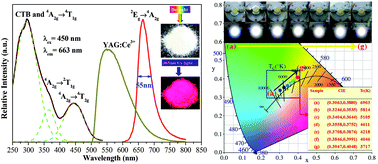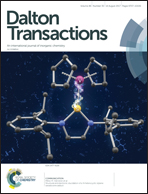Mn4+,Li+ co-doped SrMgAl10O17 phosphor-in-glass: application in high-power warm w-LEDs†
Abstract
Currently, the shortage of red components and easy aging of organic silicone still remain challenges for high-power phosphor-converted warm white light-emitting diodes (w-LEDs). Aiming to alleviate these issues, phosphor-in-glass (PiG), fabricated by co-sintering red- and yellow-emitting phosphors and low-melting glass, has been regarded as a promising color converter for w-LEDs. In this study, a Li+,Mn4+ co-doped SrMgAl10O17 red phosphor was synthesized via a conventional solid-state reaction. The as-prepared phosphor exhibits a deep red emission, ascribed to Mn4+:2Eg → 4A2g spin-forbidden transition in the range of 600–700 nm with a narrow-band full width at half maximum of 55 nm, and provides an ideal broadband excitation extending from 250 to 530 nm. Impressively, the Li+ additive used as charge compensation was beneficial to enhance the Mn4+ luminescence by allowing more Mn4+ to replace Al3+. Furthermore, the developed SrMgAl10O17:Mn4+,Li+ red phosphor and commercial YAG:Ce3+ yellow phosphor co-doped inorganic PiG were successfully fabricated as color converters to substitute organic silicone. The w-LED was fabricated by combining an InGaN blue LED chip with a PiG plate. Importantly, the constructed w-LEDs exhibited superior optical performance and tuned chromaticity feature with the correlated color temperature evolved from bluish cool white (6903 K) to yellowish warm white (3717 K), and the color rendering index increased from 69.4 to 85.5, meeting the requirements for indoor lighting.



 Please wait while we load your content...
Please wait while we load your content...